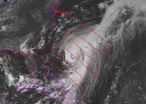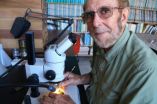(Press-News.org) The first of two unmanned Global Hawk aircraft landed at NASA's Wallops Flight Facility in Wallops Island, Virginia, on Aug. 27 after surveying Hurricane Cristobal for the first science flight of NASA's latest hurricane airborne mission.
NASA's airborne Hurricane and Severe Storm Sentinel, or HS3, mission returns to NASA Wallops for the third year to investigate the processes that underlie hurricane formation and intensity change in the Atlantic Ocean basin. HS3 is a collaborative effort that brings together several NASA centers with federal and university partners.
The two unmanned Global Hawks participating in HS3 are based at NASA's Armstrong Flight Research Center at Edwards Air Base, California, but will be temporarily housed at NASA Wallops for the duration of the HS3 mission which runs through Sept. 29. That window for the mission coincides with the peak of the Atlantic hurricane season that runs from June 1 to Nov. 30.
NASA Global Hawk 872 departed NASA Armstrong on the morning of Aug. 26 and arrived at NASA Wallops at 7:43 a.m. EDT on Aug. 27. Global Hawk number 871 is scheduled to fly to Wallops within a week.
Tropical Storm Cristobal became a hurricane late on August 25 as it was moving through the Bahamas. During the Global Hawk's 22 hour mission it flew a "lawnmower" or back and forth pattern over Hurricane Cristobal while gathering data using dropsondes and two other instruments. There were 83 dropsondes loaded in the aircraft, with two of them were dropped over the Gulf of Mexico and the other 81 dropsondes dropped over Cristobal. A dropsonde is a device that measures winds, temperature, pressure and humidity as it falls from the aircraft to the surface.
"The instruments are tested and then integrated onto each Global Hawk at Armstrong," said Marilyn Vasques, HS3 Project Manager of NASA Ames. Before the cross-country flights, the ground operations center at Wallops tested the various instruments aboard both aircraft while they were still at Armstrong. "After integration and outdoor tests we conduct a Combined Systems Test on the ground as well as a test flight near Armstrong before the instruments and aircraft are ready to transit" explained Vasques. Checking the performance of the instruments over that long distance while they were at a NASA center was critical to ensure they would operate correctly while in-flight over Atlantic hurricanes.
Now that the first Global Hawk is at Wallops, the mission will investigate any significant disturbances that might develop in the western Atlantic. The HS3 mission will investigate disturbances before they become depressions to examine how a storm forms. The mission is also looking for conditions that favor (or promote) rapid intensification of tropical cyclones.
"Twice a day we hold weather briefings looking for storms or disturbances that could become storms," said Scott Braun, HS3 Principal Investigator from NASA's Goddard Space Flight Center in Greenbelt, Maryland, working at Wallops during the mission. "We evaluate the targets in terms of our science objectives and determine which one best addresses those objectives. We factor in stage of the life cycle of the storm, likelihood of formation or intensification, interaction with the Saharan Air Layer, among other things."
During the mission period, the Global Hawks will be operated from Wallops where they will depart and fly over tropical cyclones in the Atlantic, analyzing the storms with six scientific instruments. The East Coast NASA location makes accessing Atlantic tropical cyclones easier and allows for more science data collection than if they were to fly from the West Coast. Each aircraft has an 11,000-nautical-mile range and can fly for up to 26 hours.
One Global Hawk will carry three instruments to examine the environment around the storms, including the Scanning High-resolution Interferometer Sounder (S-HIS), the Advanced Vertical Atmospheric Profiling System (AVAPS), also known as dropsondes, and the Cloud Physics Lidar (CPL).
The second Global Hawk will focus on the inner region of the storms to measure wind and precipitation, surface winds, and atmospheric temperature and humidity. It will carry the High-Altitude Imaging Wind and Rain Airborne Profiler (HIWRAP) conically scanning Doppler radar, the Hurricane Imaging Radiometer (HIRAD), and the High-Altitude Monolithic Microwave Integrated Circuit Sounding Radiometer (HAMSR) microwave sounder.
INFORMATION:
The HS3 mission is funded by NASA Headquarters and overseen by NASA's Earth System Science Pathfinder Program at NASA's Langley Research Center in Hampton, Virginia. Itis one of five large airborne campaigns operating under the Earth Venture program.
The HS3 mission also involves collaborations with partners including the National Centers for Environmental Prediction, Naval Postgraduate School, Naval Research Laboratory, NOAA's Unmanned Aircraft System Program, Hurricane Research Division and Earth System Research Laboratory, Northrop Grumman Space Technology, National Center for Atmospheric Research, State University of New York at Albany, University of Maryland - Baltimore County, University of Wisconsin, and University of Utah. The HS3 mission is managed by the Earth Science Project Office at NASA Ames Research Center, Moffett Field, California.
For more information about NASA's HS3 mission, visit: http://www.nasa.gov/hs3
For more information about an HS3 sonde, visit: http://www.nasa.gov/content/goddard/what-the-heck-is-a-dropsonde/#
NASA begins hurricane mission with Global Hawk flight to Cristobal
2014-08-27
ELSE PRESS RELEASES FROM THIS DATE:
Junk food makes rats lose appetite for balanced diet
2014-08-27
A diet of junk food not only makes rats fat, but also reduces their appetite for novel foods, a preference that normally drives them to seek a balanced diet, reports a study published in the open-access journal Frontiers in Psychology.
The study helps to explain how excessive consumption of junk food can change behavior, weaken self-control and lead to overeating and obesity.
The team of researchers, led by Professor Margaret Morris, Head of Pharmacology from the School of Medical Sciences, UNSW Australia, taught young male rats to associate each of two different sound ...
Nanodiamonds are forever
2014-08-27
Most of North America's megafauna — mastodons, short-faced bears, giant ground sloths, saber-toothed cats and American camels and horses — disappeared close to 13,000 years ago at the end of the Pleistocene period. The cause of this massive extinction has long been debated by scientists who, until recently, could only speculate as to why.
A group of scientists, including UC Santa Barbara's James Kennett, professor emeritus in the Department of Earth Science, posited that a comet collision with Earth played a major role in the extinction. Their hypothesis suggests that ...
IU study: Social class makes a difference in how children tackle classroom problems
2014-08-27
BLOOMINGTON, Ind. -- An Indiana University study has found that social class can account for differences in how parents coach their children to manage classroom challenges. Such differences can affect a child's education by reproducing inequalities in the classroom.
"Parents have different beliefs on how to deal with challenges in the classroom," said Jessica McCrory Calarco, assistant professor in IU Bloomington's Department of Sociology in the College of Arts and Sciences. "Middle-class parents tell their children to reach out to the teacher and ask questions. Working-class ...
Wolves susceptible to yawn contagion
2014-08-27
Wolves may be susceptible to yawn contagion, according to a study published August 27, 2014 in the open-access journal PLOS ONE by Teresa Romero from The University of Tokyo, Japan, and colleagues.
Researchers suggest that contagious yawning may be linked to human capacity for empathy, but little evidence apart from studies on primates, exists that links contagious yawning to empathy in other animals. Recently, researchers have documented domestic dogs demonstrating contagious yawning when exposed to human yawns in a scientific setting, but it is unclear whether this ...
Stone-tipped spears more damaging than sharpened wooden spears
2014-08-27
Experimental comparison may show that stone-tipped spears do not penetrate as deep, but may still cause more damage, than sharpened wooden spears, according to a study published August 27, 2014 in the open-access journal PLOS ONE by Jayne Wilkins from Arizona State University and colleagues.
The creation of stone-tipped weapons (wooden shaft + binding materials + stone point) by our ancestors ~500,000 years ago points to the development of new cognitive and social learning at the time. The development may have provided an advantage over simpler hunting methods, such as ...
Bronze Age wine cellar found
2014-08-27
A Bronze Age palace excavation reveals an ancient wine cellar, according to a study published August 27, 2014 in the open-access journal PLOS ONE by Andrew Koh from Brandeis University and colleagues.
Wine production, distribution, and consumption are thought to have played a role in the lives of those living in the Mediterranean and Near East during the Middle Bronze Age (1900-1600 BC), but little archaeological evidence about Bronze Age wine is available to support art and documentation about the role wine played during this period. During a 2013 excavation of the Middle ...
Xenon exposure shown to erase traumatic memories
2014-08-27
Belmont, MA — McLean Hospital researchers are reporting that xenon gas, used in humans for anesthesia and diagnostic imaging, has the potential to be a treatment for post-traumatic stress disorder (PTSD) and other memory-related disorders.
"In our study, we found that xenon gas has the capability of reducing memories of traumatic events," said Edward G. Meloni, PhD, assistant psychologist at McLean Hospital and an assistant professor of Psychiatry at Harvard Medical School. "It's an exciting breakthrough, as this has the potential to be a new treatment for individuals ...
New drug promises relief for inflammatory pain, Stanford scientists say
2014-08-27
Pain from inflammation sidelines thousands of Americans each year. Many face a tough choice: deal with the pain, take a potentially addictive opioid or use a nonsteroidal anti-inflammatory drug that may increase risk for cardiovascular disease or gastrointestinal bleeding.
Now, researchers at the Stanford University School of Medicine have discovered a compound thought to be nonaddictive and safe for the heart and gastrointestinal system that reduces inflammatory pain in mice and rats. They call the compound Alda-1.
"Finding a new pain medication is important because ...
Stone-tipped spears lethal, may indicate early cognitive and social skills
2014-08-27
Attaching a stone tip on to a wooden spear shaft was a significant innovation for early modern humans living around 500,000 years ago. However, it was also a costly behavior in terms of time and effort to collect, prepare and assemble the spear. Stone tips break more frequently than wooden spears, requiring more frequent replacement and upkeep, and the fragility of a broken point could necessitate multiple thrusts to an angry animal. So, why did early hunters begin to use stone-tipped spears?
To learn if there was a "wounding" advantage between using a wooden spear or ...
Orphaned children can do just as well in institutions
2014-08-27
DURHAM, N.C. -- The removal of institutions or group homes will not lead to better child well-being and could even worsen outcomes for some orphaned and separated children, according to new findings from a three-year study across five low- and middle-income countries.
Children in institutions are as healthy and, in some ways, healthier than those in family-based care, according to the study, which was led by Kathryn Whetten, a Duke professor of public policy and director of the Center for Health Policy and Inequalities Research (CHPIR).
In the largest and most geographically ...







